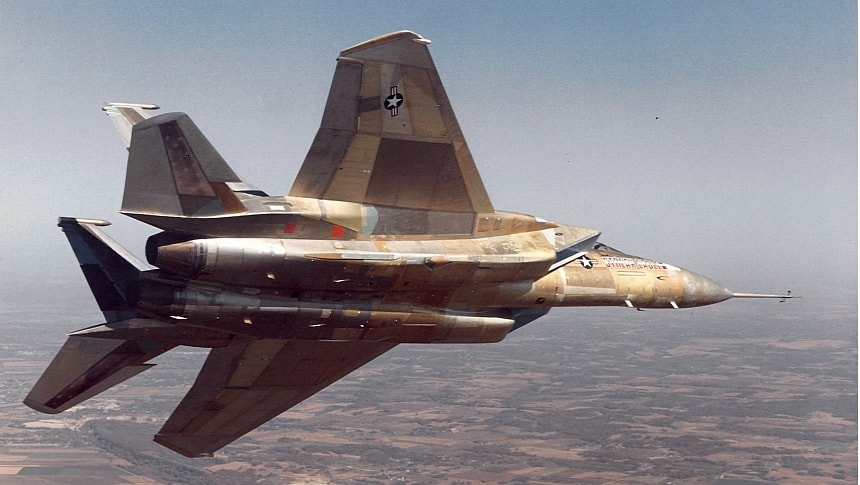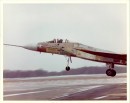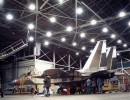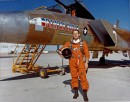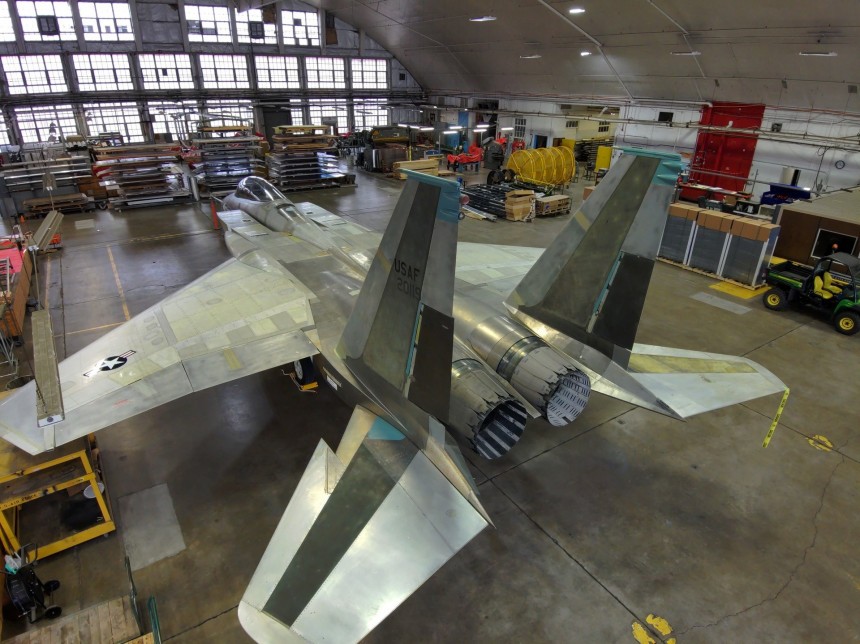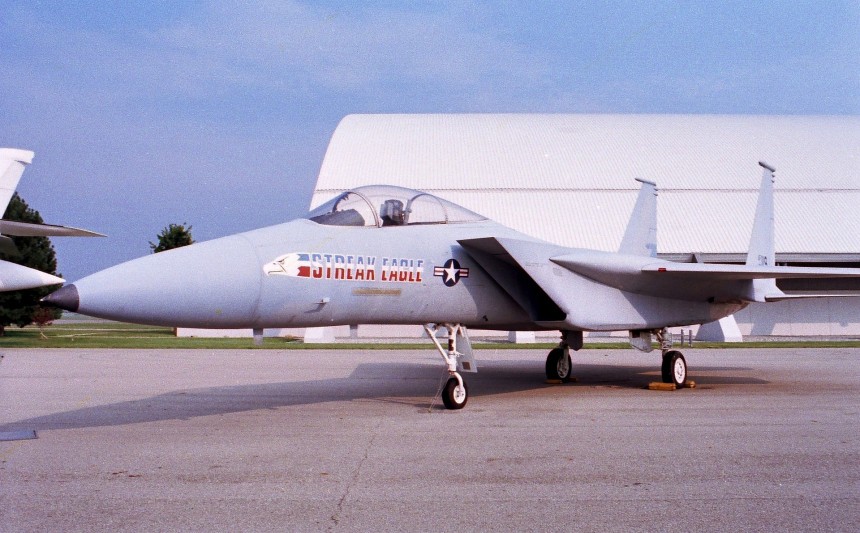The F-15 twin-engine, high-performance, all-weather air superiority fighter became operational in November 1974 as the first aircraft in the US Military arsenal that could accelerate in a vertical climb. It was also the airplane that outpaced the Saturn V moon rocket when climbing to an altitude of 100,000 feet (just over 30,000 meters).
After they got their hands on the first batch of combat-ready F-15s in late 1974, the top hats of the United States Air Force realized that the fastest PR stunt the new fighter could pull would be to smash aviation records. By January 1975 – less than two months after its commissioning – the aircraft was dropping previous world records like bowling pins.
The major race was not against its predecessor, the F-4 Phantom, but aimed at the perennial cold-war rival, the Soviet Union. Specifically, the MiG-25 Foxbat - the 3.2-Mach capable fighter developed to hunt down the legendary SR-71 Blackbird. The Soviet warplane was considered a severe threat to the best U.S. fighters of the era, and the F-15 was updated to match the MiG.
However, without a direct, head-to-head confrontation, the next best tool to assess the newly launched ‘Strike Eagle’ was to set new records that would be recognized worldwide, regardless of politics. And so, the race was on to its next round: time-to-altitude climb. USAF and McDonnell Douglas put on quite a show with a specially modified F-15 – named ‘Streak Eagle’ which broke five world records in one day and eight over two weeks and three days.
Three USAF pilots were designated to reclaim the crown for the U.S. between January 16 and February 1, 1975, over Grand Forks Air Force Base in North Dakota. They took turns in the cockpit of the modified airplane and blasted through previous achievements at supersonic speeds and on full afterburner. The aircraft was essentially a stripped-down preproduction version of the combat airplane.
All unnecessary deadweight was removed – including the paint, 20-mm Vulcan rotary cannon and ammo, radars, radios, and other non-essentials. A pitot boom was fitted to the nose, and high-accuracy instruments were installed for precise speed and acceleration measurements. Thanks to its thrust-to-weight ratio of nearly 1.5:1, the specially-prepped F-15 would set eight records during the 17 days of testing.
On January 16, the five F-4-Phantom II records fell during three attempts made by the F-15. The ‘Time to 3,000 m (9,843 feet)’ was improved by Major Roger Smith by a 20% margin, from 34.52 seconds to 27.57 seconds. A hold-back system was fitted to the Streak Eagle, which then accelerated to full throttle before being released. The short takeoff distance of 400 m (1,220 feet) left very little time for the pilot to retract the landing gear before pulling a 5G vertical climb.
Due to this detail, several attempts were aborted as the aircraft neared the never-exceed speed for the landing gear and had to slow down, compromising the trial. However, the pilot eventually got the hang of it and smashed the standing record.
A second flight that same day broke three records, with Major Willard Macfarlane at the stick. ‘Time to 6,000 m, 9,000 m, and 12,000 m’ (19,685 ft, (29,528 ft, and 39,370 ft)’ were simply obliterated by the Streak Eagle’s fast ascend. The old world bests were 48.79 seconds, 61.68 seconds, and 77.14 seconds. The F-15 did it in 39.33 s, 48.86 s, and 59.38s.
In the afternoon, the plane took off one last time for the day, going for the 15,000-meter ceiling (49,212 ft), shaving 37 seconds (or 33%) off the old 114.50 seconds. The twin-engine fighter hit the mark in 77.02 seconds, around 10 seconds quicker than the Saturn V Moon rocket. See the video attached for a detailed and accurate report of the events.
Having taken the crown from the aging F-4, the new kid on the block put the Soviet fighter in its sights and floored it. Or, better yet, 'ceiling’ed' it since the next thresholds lay at or beyond 20,000 m overhead. On January 19, Roger Smith aced the ‘Time to 20,000 m (65,617 ft)’ flight, seeing the MiG-25’s 169.80 seconds and raising the Eagle’s 122.94-second performance.
Seven days later, Major Dave Peterson put on the high-pressure suit (all attempts above 15,000 m / 50,000 feet required this special equipment) and dropped below the three-minute mark in the high-speed, high-altitude record. In 1974, the Soviet aircraft hit the required level in 192.60 seconds (three minutes and twelve seconds), while the Eagle managed a 161.02-second performance (two minutes and forty-one seconds).
Finally, on February 1, 1975, the man who first clubbed previous records, Major Roger Smith, got in the cockpit one last time and aimed for the absolute win: ‘Time to 30,000 m (98,425 ft).’ The F-15 outpaced the MiG-25 by over half a minute, scoring 207.80 seconds, compared to the MiG’s 243.86 seconds. Maj. Smith shut down the twin jets after smashing the record to protect the engines from overheating and suffering irreparable damage.
Due to its 2.2-Mach momentum, the Streak Eagle continued on a ballistic trajectory, coasting silently until it hit 103,000 ft (33,792 meters). The extremely thin atmosphere wasn’t absorbing the engines’ heat quickly enough, so the plane – essentially a glider flying at just 55 knots (63 miles per hour, 102 kilometers per hour) – was moving solely on inertia. The pilot pushed over into a 55-degree dive until the plane reached a safe altitude of 55,000 feet (16,764 meters). Major Smith reignited the engines, and the F-15 Streak Eagle safely returned to land at Grand Forks.
The record-setting F-15 was an early version of the standard fighter, 63 feet, 9.0 inches (19.4 meters) long, with a wingspan of 42 feet, 9.7 inches (13 meters), and 18 feet, 5.4 inches (5.6 meters) long. A regular F-15 had an empty weight of 25,870 lbs (11,734 kilograms) and a maximum takeoff weight (MTOW) of 44,497 lbs (20,184 kilograms).
However, the Streak Eagle was 1,800 lbs (817 kg) lighter than a production F-15A. Furthermore, its twin jets were given only the strict amount of fuel necessary to carry the record-breaking attempts. The two Pratt&Whitney afterburning turbofan engines have a Maximum Continuous Power rating of 12,410 lb of thrust (55.2 kilonewtons), a 14,690-lb (65.34 kN) 30-minute limit, and a peak 23,840-lb (106 kN) 5-minute limit.
An F-15A Eagle can cruise at 502 knots (578 mph / 930 kph hour), with a top speed of 893 knots (1,028 mph / 1,654 kph) at 10,000 feet (3,048 meters). The supersonic jet can hit 1,434 knots (1,650 mph / 2,656 kph) at 45,000 feet (13,716 meters), and its operational ceiling is 63,050 feet (19,218 meters) at max thrust. The regular F-15s had a thrust-to-weight ratio of 1.15:1, enabling them to climb at 67,250 feet per minute (342 meters per second) from sea level.
The record-setting F-15 Streak Eagle was donated to the National Museum of the U.S. Air Force in 1980 and put on outside display. A coat of camouflage grey paint was sprayed on the historic plane to protect its bare-metal body. The fighter wore the famous livery for over four decades, but it has been recently restored to its correct exposed aluminum finish. It is currently in storage in a hangar at the Museum.
The major race was not against its predecessor, the F-4 Phantom, but aimed at the perennial cold-war rival, the Soviet Union. Specifically, the MiG-25 Foxbat - the 3.2-Mach capable fighter developed to hunt down the legendary SR-71 Blackbird. The Soviet warplane was considered a severe threat to the best U.S. fighters of the era, and the F-15 was updated to match the MiG.
However, without a direct, head-to-head confrontation, the next best tool to assess the newly launched ‘Strike Eagle’ was to set new records that would be recognized worldwide, regardless of politics. And so, the race was on to its next round: time-to-altitude climb. USAF and McDonnell Douglas put on quite a show with a specially modified F-15 – named ‘Streak Eagle’ which broke five world records in one day and eight over two weeks and three days.
All unnecessary deadweight was removed – including the paint, 20-mm Vulcan rotary cannon and ammo, radars, radios, and other non-essentials. A pitot boom was fitted to the nose, and high-accuracy instruments were installed for precise speed and acceleration measurements. Thanks to its thrust-to-weight ratio of nearly 1.5:1, the specially-prepped F-15 would set eight records during the 17 days of testing.
On January 16, the five F-4-Phantom II records fell during three attempts made by the F-15. The ‘Time to 3,000 m (9,843 feet)’ was improved by Major Roger Smith by a 20% margin, from 34.52 seconds to 27.57 seconds. A hold-back system was fitted to the Streak Eagle, which then accelerated to full throttle before being released. The short takeoff distance of 400 m (1,220 feet) left very little time for the pilot to retract the landing gear before pulling a 5G vertical climb.
A second flight that same day broke three records, with Major Willard Macfarlane at the stick. ‘Time to 6,000 m, 9,000 m, and 12,000 m’ (19,685 ft, (29,528 ft, and 39,370 ft)’ were simply obliterated by the Streak Eagle’s fast ascend. The old world bests were 48.79 seconds, 61.68 seconds, and 77.14 seconds. The F-15 did it in 39.33 s, 48.86 s, and 59.38s.
In the afternoon, the plane took off one last time for the day, going for the 15,000-meter ceiling (49,212 ft), shaving 37 seconds (or 33%) off the old 114.50 seconds. The twin-engine fighter hit the mark in 77.02 seconds, around 10 seconds quicker than the Saturn V Moon rocket. See the video attached for a detailed and accurate report of the events.
Seven days later, Major Dave Peterson put on the high-pressure suit (all attempts above 15,000 m / 50,000 feet required this special equipment) and dropped below the three-minute mark in the high-speed, high-altitude record. In 1974, the Soviet aircraft hit the required level in 192.60 seconds (three minutes and twelve seconds), while the Eagle managed a 161.02-second performance (two minutes and forty-one seconds).
Finally, on February 1, 1975, the man who first clubbed previous records, Major Roger Smith, got in the cockpit one last time and aimed for the absolute win: ‘Time to 30,000 m (98,425 ft).’ The F-15 outpaced the MiG-25 by over half a minute, scoring 207.80 seconds, compared to the MiG’s 243.86 seconds. Maj. Smith shut down the twin jets after smashing the record to protect the engines from overheating and suffering irreparable damage.
The record-setting F-15 was an early version of the standard fighter, 63 feet, 9.0 inches (19.4 meters) long, with a wingspan of 42 feet, 9.7 inches (13 meters), and 18 feet, 5.4 inches (5.6 meters) long. A regular F-15 had an empty weight of 25,870 lbs (11,734 kilograms) and a maximum takeoff weight (MTOW) of 44,497 lbs (20,184 kilograms).
However, the Streak Eagle was 1,800 lbs (817 kg) lighter than a production F-15A. Furthermore, its twin jets were given only the strict amount of fuel necessary to carry the record-breaking attempts. The two Pratt&Whitney afterburning turbofan engines have a Maximum Continuous Power rating of 12,410 lb of thrust (55.2 kilonewtons), a 14,690-lb (65.34 kN) 30-minute limit, and a peak 23,840-lb (106 kN) 5-minute limit.
The record-setting F-15 Streak Eagle was donated to the National Museum of the U.S. Air Force in 1980 and put on outside display. A coat of camouflage grey paint was sprayed on the historic plane to protect its bare-metal body. The fighter wore the famous livery for over four decades, but it has been recently restored to its correct exposed aluminum finish. It is currently in storage in a hangar at the Museum.
